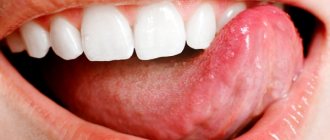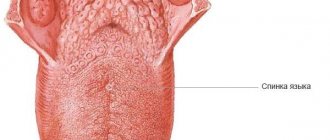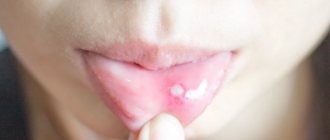Publication date: 01/27/2021
Just as poets consider the eyes to be the mirror of the soul, so doctors are accustomed to viewing the tongue as an organ that reflects the work of the body as a whole. No matter what you complain about, the doctor at the appointment will definitely ask you to stick out your tongue and carefully examine it. And at the dentist’s appointment, special attention will be paid to the tongue. And all because of glossitis. The word is beautiful, but the condition is not. Glossitis is an inflammation of the tongue, one of the signs of which is the appearance of cracks.
Tongue in cracks - reasons
- Bacterial and viral infections
This doesn't just apply to infections in the mouth. Viruses and bacteria spread throughout the body, and the infection manifests itself in the tongue. Most often, cracks in the tongue are caused by the herpes virus. - Anemia
Iron deficiency can cause glossitis. Iron is transported by a special protein - myoglobin, which is responsible for the healthy state of muscle tissue. If there is not enough iron, all muscles suffer, including the tongue. - Allergic reaction
The body's response to various allergens: food, medications, sometimes even toothpaste components - can cause inflammation. - Mouth injuries
Burns, cuts, and any mechanical injuries become an environment where bacteria multiply, which means inflammation occurs. - Vitamin deficiency
It has been scientifically proven that a deficiency of B vitamins can lead to cracked tongue.
Diagnostics
Successful therapy requires careful research. Diagnostics in dentistry include an initial consultation with a dentist, and, if necessary, specialists. It is the dentist who deals with problems related to the oral cavity. Usually, after the dentist, the patient is sent to a therapist in order to study the clinical picture. Finding out the medical history allows you to determine which specialists to refer the patient to.
A loose tongue with cracks requires inspection:
- Hematologist;
- Gastroenterologist;
- Endocrinologist;
- Infectious disease specialist;
In addition, the patient is sent for blood tests, and a scraping of epithelial tissue in the area of the furrow is taken. The condition of the gastrointestinal tract is assessed, and other studies are carried out, which make it possible to assess the state of the body. All these examinations allow us to identify the true cause of the defect.
Symptoms
Inflammation manifests itself in different ways, depending on the individual characteristics of the person and the underlying cause of the disease. Common symptoms include:
- Unpleasant sensations in the mouth
- Color change
- Pain
- Edema
- Burning or itching
- Surface change
- Changes in the size and shape of the papillae
- Cracks
- Difficulty swallowing
- Chewing problems
- Gray plaque
- Difficulty speaking
Forms and types of disease
Inflammation of our organ of taste occurs frequently and does not always manifest itself with symptoms, proceeding completely hidden from us.
There are several forms and types of the disease:
- According to the duration, the disease is divided into acute (develops quickly and lasts no more than a month) or chronic glossitis (lasts more than a month);
- According to the form of the lesion, the catarrhal form (proceeding with redness and swelling) and the desquamative form (proceeding with a change in appearance) are distinguished;
- purulent forms - phlegmon and abscess (a purulent focus in the thickness of the organ tissue itself);
- a separate group includes neurological diseases of the nerves innervating this organ.
Cellulitis and abscess occur acutely, they are associated with infection and require urgent surgical intervention. They manifest themselves as severe pain, chills and swelling of the lymph nodes of the neck - this form can be confused with acute inflammation of the salivary glands, so diagnosis using ultrasound and x-rays is needed. It is better not to delay these symptoms and seek medical help as an emergency.
The catarrhal form of glossitis manifests itself with a sharp blood supply - the tongue swells, becomes bright red - this can manifest itself, for example, with scarlet fever, or an allergic reaction, which, in addition to the organ of taste itself, spreads to the soft palate with the tongue. Treatment in this case is aimed at eliminating the allergic reaction and inflammation.
The largest and most heterogeneous group is desquamative glossitis. It is difficult to list the number of factors (external, internal) that can provoke this form of the disease. We will not make a mistake if we say that “the tongue is the mirror of the digestive tract.” Since it contains many nerve receptors and papillae of different shapes and purposes (filamentous, cone-shaped, mushroom-shaped, leaf-shaped, groove-shaped), a change in each link of its anatomy outwardly reveals a hidden disease. Let's take a little look at the most common diagnostic signs of these conditions.
Online consultation with a doctor if you are concerned about symptoms
If you are concerned about cracks in the tongue and the symptoms listed in the article: discoloration, swelling, pain, burning, difficulty swallowing and speaking due to an enlarged tongue, consult a doctor. To identify a disease with similar symptoms, in most cases, a visual examination is sufficient. An online consultation with a dentist will help you timely recognize the degree of soft tissue damage, the exact location and the appropriate treatment regimen. If you do not pay attention to cracks in the tongue, you may not notice more serious diseases and complications from them: abscesses, phlegmons. Treatment in this case will be long and more expensive.
Is it worth treating glossitis with folk remedies?
If you have a question: how to cure glossitis, don’t waste time looking for folk remedies! If you notice characteristic symptoms that do not go away for more than a day, you need to seek help from a specialist. Treatment of glossitis should be carried out only by a dentist, who will determine the cause of the changes in the oral cavity, carry out all the necessary therapeutic and diagnostic procedures, prescribe a set of therapeutic measures that the patient can perform at home, and also monitor the entire treatment process, making changes to it as needed. necessary adjustments. Moscow dental clinics are presented in the “Search” section on our website.
Glossitis, like other periodontal diseases, is fraught with many complications, so treatment with folk remedies can only serve as an aid in complex therapy.
In order not to come face to face with glossitis, it is enough to brush your teeth regularly, including brushing your tongue, and do not skip preventive examinations at the dentist. In addition, doctors recommend avoiding excessive consumption of spicy foods and spices, limiting the intake of alcoholic beverages and smoking. Remember, disease is easier to prevent than to treat.
Treatment in the clinic
Before prescribing medications and procedures, it is necessary to find out why cracks occur. After this, a plan is drawn up, which may include:
- Treatment of a common disease
- Antifungal medications
- Iron tablets
- Vitamins
- Corticosteroids
- Immunostimulants
- Antihistamines
The surface of the tongue is disinfected with antiseptic solutions. Painkillers are used to reduce pain.
If mechanical injuries occur as a result of unsuccessful prosthetics, it is recommended to replace the structure.
Allergic reactions
Did cracks appear on your tongue out of nowhere? Pay attention to your personal hygiene products; perhaps the reason is unsuitable toothpaste or mouth rinse. Or maybe you recently started taking medications that led to a similar reaction.
It will be enough to stop using the product and take a course of antihistamines so that the tongue in the cracks no longer bothers you. After such manipulations, the symptoms will naturally disappear.
“I really like to eat sour fruits, I love citrus fruits. There was a time when I couldn’t live a day without them. However, something bad happened to me; one morning I felt pain and a burning sensation on my tongue. Looking in the mirror, I saw that he also looked extremely unpleasant. The doctor said that this is an allergy to citrus fruits, that in principle you can’t eat a lot of them, and they are even dangerous for the mucous membranes.”
[email protected] , from correspondence on the forums
Home Remedies
Folk remedies are not able to eliminate the cause of cracks, especially if it is a common disease. In rare cases, the body can defeat a bacterial infection on its own. Therefore, medications from a home medicine cabinet can only be considered auxiliary. These include:
- Gargling with decoctions of sage and chamomile
- Lotions with sea buckthorn or olive oil
- Propolis
- Potato juice applications
Incorrectly selected folk remedies can reduce the effect of drug treatment.
Be sure to consult your doctor.
What is glossitis?
Glossitis (from the Greek glossa (tongue) + suffix –itis) is an inflammation of the tongue. The reasons for its occurrence are different. Glossitis can develop as a result of a viral or bacterial infection, or as a result of another disease in the body. In addition, there are some other factors that provoke the development of the disease. These include mechanical, chemical and thermal damage to the oral cavity; nicotine; food that is too spicy or too hot; alcohol; caramel; some components present in toothpastes.
Glossitis has the following forms:
- folded
- diamond-shaped median
- desquamative
- hairy black
- Gunter's
- interstitial
According to the duration of the inflammatory process, acute and chronic glossitis are distinguished. The acute form of glossitis manifests itself as inflammation of the tongue, a change in its structure or color. Symptoms of the chronic form are more varied, but in most cases the disease is diagnosed by the presence or absence of papillomas - fungal growths on the tissues of the tongue. There are cases when the cause of the disease can be identified only after comprehensive medical research. True, this happens quite rarely and, as a rule, is associated with the presence of congenital, hereditary diseases.
Top five dental clinics
All clinics on the list are multidisciplinary. They are engaged in prevention, treatment, prosthetics and implantation.
| Dental center | Clinic address | General information |
| Cerecon | Moscow, Andropova Ave. 8 | Metro Technopark. Opening hours: 24 hours a day |
| ROOT | Moscow, st. Rustaveli, 14 building 9 | Metro Butyrskaya. Opening hours from 10:00 to 22:00 |
| Alpha-Dent | Moscow, Beskudnikovsky blvd., 24, bldg. 1 | Metro Petrovskoye-Razumovskoye. Open all days of the week. |
| MegaStom | Moscow, Bolshoi Kozlovsky lane, building 10, building 2 | Metro Red Gate. They don't work on Sundays |
| Denta amo | Moscow, st. Grekova, 9 | Metro Medvedkovo Open daily from 9 to 9. |
Which doctor should I contact?
The answer to the question of which doctor treats glossitis is simple. When painful changes appear in the mouth, patients turn to the dentist. This specialist will help alleviate the condition, but there is a high chance that damage to the taste organ is only a symptom of changes in the body. It is not always possible to determine the disease by the tongue; additional studies are prescribed. Consultations with a hematologist, endocrinologist and gastroenterologist may be required, diagnostics including:
- external examination of damage, swelling;
- epithelial scraping examination;
- blood analysis;
- identification of concomitant chronic or acute diseases.
Cleaning your tongue with a home irrigator
As an alternative to going to the dentist for professional oral cleaning, you can consider a home irrigator. This is a special device equipped with replaceable nozzles and a reservoir that supplies liquid under pressure to clean the space between the teeth. When choosing an irrigator, you must be guided by the following requirements:
- the number of attachments should be a multiple of the number of family members who will use it, because this is a means of individual use;
- It is highly desirable that the kit include devices for cleaning the tongue and dentures of any configuration;
- it is necessary that the device be equipped with a pressure regulator when supplying liquid, because everyone has an individual level of tooth sensitivity;
- It is better to choose a larger tank volume, this will allow cleaning more efficiently;
- It would be great if it was also equipped with a water supply regulator, that is, it could be a stream of water or a spray.
This device will save you the time and money needed to visit the dentist's office.
Plaque for bronchitis and pneumonia
The area of the tongue immediately following its tip is an indicator of the health or disease of the respiratory system (bronchi and lungs). Based on the condition of this area, one can judge the presence of bronchitis or pneumonia:
- Red spots indicate that pneumonia or bronchial asthma is possible.
- A light film on the front of the tongue indicates the presence of a respiratory allergy or congestion in the lungs.
Plaque on the tongue caused by inflammatory processes of the upper and lower respiratory tract is not decisive in the diagnosis of these diseases.
Anatomical structure of the tongue
The structure of human language corresponds to its multifunctionality, which lies in the fact that it participates in the processes:
- chewing;
- salivation;
- taste perception;
- speech.
The body of the tongue consists of striated muscle tissue, which is covered by a membrane of mucous tissue. Its surface, called the back, is conventionally divided into three parts:
- the last third, located near the pharynx, is called the root;
- the first two thirds are the body of the tongue.
A longitudinal groove runs in the middle, which is an external manifestation of the internal septum; it is, in fact, a reduced thyroglossal duct.
The mucous membrane, tightly adjacent to the muscle tissue, is covered on the outside with stratified squamous epithelium. It contains:
- salivary glands;
- taste buds;
- lymphatic ducts.
The mucous membrane of the posterior part forms three supraglottic folds, with the help of which the tongue is attached to the larynx:
- median;
- two lateral.
The tongue is abundantly covered with papillae, including:
- filamentous - act as organs of touch and, thanks to the rough surface, hold food on the tongue;
- cone-shaped – responsible for sensitivity to temperature and pain;
- mushroom-shaped - equipped with taste buds, thanks to them we distinguish many taste sensations;
- groove-shaped - located near the root, have serous glands and are also responsible for the sense of taste;
- leaf-shaped - equipped with lingual glands that secrete a mucous secretion.
The tongue is attached to the oral cavity by a fold of mucous membrane called the frenulum.
Determining the disease by the color of plaque
The first diagnostician on the condition of the tongue was the Russian doctor M. A. Nechaev, who in 1833 published the book “Recognition of diseases by changes in the language” in the printing house of Kazan University. Several generations of Russian doctors were grateful to him for this unique work, which helped to carry out diagnostics without additional instruments.
Today, the technique is widely used not only among traditional healers, but also among practitioners of traditional medicine. However, the diagnosis must be confirmed after a comprehensive examination carried out in a laboratory, or using ultrasound, CT, MRI, fluoroscopy, etc.
What do you pay attention to during this diagnosis:
- plaque color;
- its consistency.
As for the color of plaque, it can be:
- white;
- grey;
- yellow;
- greenish;
- bluish;
- brown;
- even black.
And the consistency can be:
- almost transparent;
- flaky;
- viscous.
All signs are compared, and a certain diagnostic verdict is made.
Why does plaque appear on the tongue?
The tongue is a muscular organ that can tell a lot about the state of the body. It is soft and easily mobile, and has a pale pink color if the person is healthy. From time to time, plaque may appear on the mucous membrane, the density of which is often seasonal. This is explained by the fact that at different times of the year the body needs certain vitamins. For example, in summer the deposits are thicker and more saturated. At this time they may acquire a yellow tint.
Bacteria constantly accumulate on the mucous membrane of the tongue. These microorganisms are the cause of plaque and bad breath.
The following factors contribute to their intensive reproduction:
- excessive alcohol consumption;
- smoking;
- poor nutrition;
- infections and inflammatory processes;
- taking medications;
- chronic diseases;
- poor oral hygiene.
Since the tip of the tongue is mobile, it is cleaned more and, accordingly, there is less plaque here. At the root, its density is higher, since in this place there is contact only with the sky. Such manifestations are also possible with dysbacteriosis, vitamin deficiency, and improper hygiene.
Localization of cracks
The position of the cracks is not random. Localization is divided into three types, each of which is caused by specific problems. You can independently identify the type of localization by assessing the position of the cracks in the tongue: in the center, on the sides or at the tip.
The presence of cracks only at the tip of the tongue indicates the following causes of the problem:
- Thermal damage. Hot food first comes into contact with the tip of the tongue and causes major damage to it. Often the problem is contact with a hot metal spoon.
- Chemical damage. Occurs from contact with spicy, sour foods or corrosive substances.
- Physical impact. The tip can crack due to an incorrect bite or a cut on the sharp protruding parts of the incisors and canines.
Photo: cracks on the sides of the tongue
The formation of cracks in the tongue in the middle has a different reason, since it is almost impossible to injure this area without touching the periphery. This means that inflammation is an indicator of pathology or disease of internal organs. In addition, the formation of cracks in the center is possible when the middle area dries out, local circulation is impaired, or the immune system is weakened. There may be only one crack; upon examination, it appears as if the tongue has split into two parts.
The presence of cracks on the sides of the tongue can be caused by various reasons. If the inflammatory process is present on the side on one side, then this means physical damage from the sharp edges of small and large molars or dentures. If the tongue is cracked on both sides, it means that there are serious malfunctions in the functioning of the body , where glossitis acts only as an indicator of pathology.
Lifestyle change
If a person’s tongue is covered with cracks, then it is necessary to exclude irritating factors when eating. This means that you need to remove hot, hot and spicy foods from your diet. It is necessary to limit the intake of store-bought and homemade marinades, sauces, and fried foods.
A balanced intake of vitamins A and B will help improve your general condition, which will have a beneficial effect on the speed of the process of getting rid of cracks. To provide the body with B vitamins and carotenes, you need to eat plant foods. Vitamin A and B12 are found in high concentrations in animal liver, dairy products and fish oil. In winter, if there is a shortage of vegetables and fruits that have not undergone deep heat treatment, it is necessary to take multivitamins.
Careful oral hygiene is required. It is better to clean teeth from plaque using a soft brush to avoid physical impact on the injured surface of the tongue, especially if it hurts.
Smoking is a significant problem because nicotine contributes to the development of stomatitis and gingivitis, diseases that often accompany glossitis . If your tongue is cracked, you should not drink strong alcohol, as it will cause burns to open wounds, which will take a long time to heal.
If a patient detects cracks in the tongue, doctors talk about a serious stage of glossitis, which must be treated urgently. In most cases, the treatment prognosis is favorable, and the technique depends on the causes of the disease, the neglect of the process and the presence of concomitant pathologies. The speed and effectiveness of therapeutic measures is directly related to how the patient complies with the recommendations of doctors.









